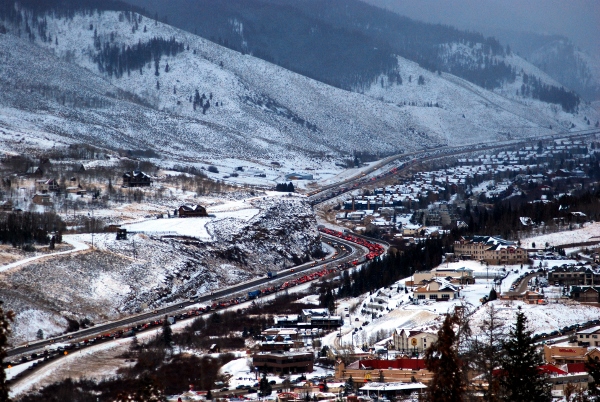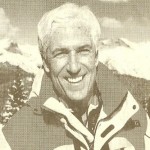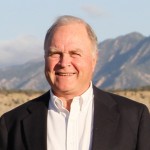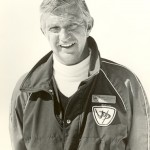Widgetized Section
Go to Admin » Appearance » Widgets » and move Gabfire Widget: Social into that MastheadOverlay zone
Ski industry veterans say I-70 bottleneck is hurting entire state
Mayor Daly seeks short-term fixes for gridlock between Denver, Vail
Vail Mayor Andy Daly’s youngest son is ski patrolling in France this ski season and he and his wife went over to visit. On their way home they flew the 5,000 miles direct from Frankfurt to Denver on Lufthansa in nine hours. But because of gridlocked Interstate 70 traffic, it took them more than seven hours to drive the 120 miles from Denver International Airport to Vail.
Reached by phone at DIA last week, where he was waiting to catch a plane to Salt Lake City for a town fact-finding trip to rival ski town Park City, Daly said flat-out, “It was a terrible year” for I-70 traffic and closures.
It’s only about a six-hour drive from Vail to the ski resorts of Utah’s Wasatch Mountains, where the ski areas are just a little over a half-hour drive from Salt Lake City, but drive times between Vail and Denver this past ski season sometimes topped nine hours because of closures on Vail Pass, at the Eisenhower Tunnel and other problem stretches between Georgetown and Idaho Springs.
“I think that’s going to begin to hurt Colorado as people look to places that have a great lifestyle, and part of that lifestyle is easy access to recreation,” Daly said. “We’ve got some vulnerability, and if we don’t address I-70, it’s going to be just another competitive disadvantage for Colorado as it tries to compete with the likes of Utah.”
Bottleneck hurting whole state
Daly a member of the Colorado Ski and Snowboard Museum Hall of Fame, is a longtime ski resort executive and developer who has run resorts from Copper Mountain to Vail. He now co-owns Powderhorn ski area near Grand Junction, and he says the I-70 bottleneck is hurting the state’s entire ski industry.
A future Colorado Olympic bid might provide the funds for a long-term fix along the I-70 corridor, Daly says, but the state can’t wait till 2026, 2030 or beyond to start finding solutions. Other small resort operators agree.
“[The Olympics] may be a way to get that high-speed rail or whatever it is on I-70 if you have to move Olympic crowds back and forth, because you definitely can’t do it on our roads the way they are,” said Tom Jankovsky, general manager of Sunlight Mountain Resort near Glenwood Springs.
Jankovsky, also a member of the Colorado Ski Hall of Fame, said that even Sunlight, 170 miles from Denver, is adversely impacted by the I-70 traffic snarls on weekends.
“Our weekend customers in January and February are from the Front Range, and it’s no doubt [I-70] affects us,” Jankovsky said. “They’re not coming up for day skiing. They’re coming up for the weekend. But they still have to get back to work, and that Sunday afternoon traffic is horrendous.”
The earliest Colorado might be able to land the Winter Olympics is 2026 – but more likely 2030 if the United States Olympic Committee first opts for a 2024 Summer Games bid. Daly said the state simply can’t wait that long for meaningful operational changes along the I-70 corridor.
“The Olympics, the potential for 2026, that would be a great time to get a project like [high-speed rail] initiated, but between now and then, the more traditional upgrades, with truck lanes and maybe some expansion of lanes that may involve tolling, that’s the direction we need to head more immediately,” Daly said.
Daly also thinks the state needs to work with the trucking industry to curtail semi traffic in general and the use of double tractor trailers in particular on Vail Pass and the Eisenhower Tunnel during peak weekend skier-traffic periods, especially when it’s snowing.
And commercial and private vehicles should possibly be subject to traction checks for snow tires and chains in adverse weather, Daly said, noting that used to be the norm on U.S. 6 over Loveland Pass before I-70 was built in the 1970s. Fines like the $1,000 penalty for unchained semis ought to be considered for private vehicles that cause highway closures, he added.
“Colorado has gained a reputation as being a progressive state,” Daly said. “Our employment numbers are among the top 10 in the nation right now. There’s a vibrancy and there’s an energy, and part of that is tied to the quality of life.
“Well, right now I-70 is really impacting the quality of life. It’s not only in the wintertime, although that’s obviously the most unpredictable, but Sunday afternoons in the summertime are actually a big issue now, and the traffic volumes are actually higher then.”
‘I’m not sure I-70 can be fixed’
Jerry Groswold, a Hall of Fame member who headed up Winter Park Resort for 22 years and was on the Denver Olympic Committee that landed the 1976 Games, said he hopes the Olympics never come to Colorado if they cost the $50 billion Russia spent for the 2014 Sochi Winter Olympics.
“That is unconscionable. Think of what you could do for $50 billion in the state of Colorado,” Groswold said. “Maybe you could fix I-70, but I’m not sure I-70 can be fixed.”
Groswold, whose office for years was within earshot of the Moffat Tunnel and the arrival of the now-defunct Winter Park Ski Train, said he doesn’t even think pumping a state-estimated $16.5 billion into high-speed mass transit along I-70 would do much to ease the weekly bottleneck.
“I’m not sure you solve it with rail,” he said. “A train will only carry so many people. You get 800 people on a train and you’ve probably eliminated 400 cars. That’s not an awful lot.”
The only solution, Groswold said, might be one that former political strategist and Colorado Ski Country USA chief John Frew floated years ago.
“He basically said you can only cram so much through a needle’s eye,” Groswold said. “I-70 is already full. You expand it and it’s still going to be full. Give up on it and go find a new route. Go to the south or go to the north and build a new access route to the Western Slope.”
In fact, where the Ski Train used to cut under the Continental Divide at Rollinsville southwest of Boulder is a manageable 3-percent grade, Groswold said, or a second highway could be built through South Park and over either Hoosier Pass or Fremont Pass into Summit County.
Regardless of when – or if – the I-70 bottleneck is solved, Groswold said the state should go after the Olympics if they can turn a profit and produce lasting infrastructure. The International Olympic Committee won’t hold a grudge against Colorado voters for rejecting the 1976 Games for financial reasons, he added.
Groswold, who served as a consultant to smaller ski areas after leaving Winter Park, agrees the state’s ski industry as a whole – even the smaller resorts – would benefit from the Olympics. And he adds that the state’s small ski areas are critical as feeders for the larger resorts.
“If you don’t think people can learn well on small hills, take a look at Olympic teams and pay attention to the number of kids who come from, for instance, a place like Buck Hill [in Minnesota, where Lindsey Vonn learned],” Groswold said. “Look at the alpine skiers that came out of Steamboat. They learned on Howelsen Hill.”
This story was produced for the Colorado Ski & Snowboard Museum and a version first ran in the Vail Daily. The museum is located on the third level of the Vail Village parking structure, adjacent to Vail Village Covered Bridge. It is open daily from 10 a.m. to 6 p.m. For more information, call 970-476-1876 or go to www.skimuseum.net.







Matt Frampton
April 7, 2014 at 3:16 pm
There might be a simple solution, which occurred to me one day while stuck not moving for an hour or so just east of Georgetown: congestion pricing using electronic toll readers, not toll booths. The cost per car during peak hours headed west on Sat / Sun morning and east on Sat / Sun afternoons, b/w, say, 2pm and 6:30pm, is $20 – $30 per car. After 6:30pm it drops to $5 – $10. After 8:30pm, it’s free. For commercial trucks, you set their price to incentivize them to plan their travel for other times.
You meter based on where a car exited and where it got on 1-70, and for cars with an EZPASS or similar, the fee is simply charged to their credit card. Those without a card can go online and pay within 7 days of their trip (lots of states do this now vs. having physical toll booths).
It’s a simple solution that would not cost a fortune to implement, would generate huge revenue, and has been tried successfully in many states and cities around the world. Some front-range skiers would suck it up and pay while some would stay in the ski towns, have dinner, shop, spend money locally, and wait for the price to drop.
Michael Beckley
April 7, 2014 at 6:01 pm
Thank heavens “Ski executives” have weighed in on what we’ve known for 40 years!
Why weren’t they kicking and screaming back then when the fix should have begun.
As it is right now….it can’t be fixed.